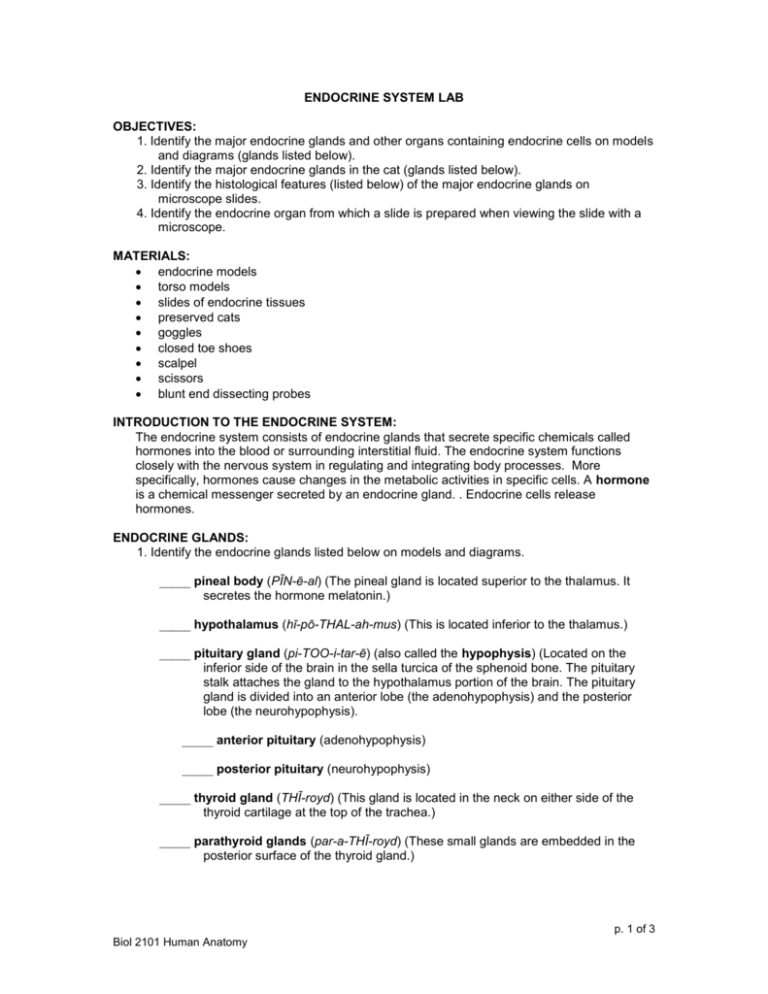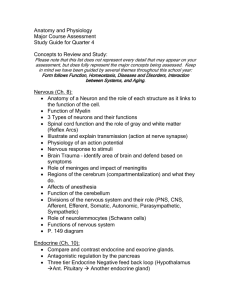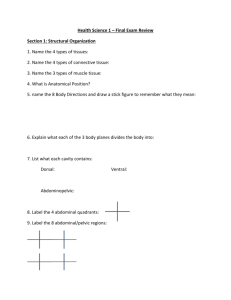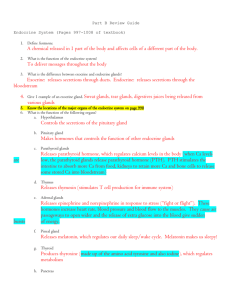4: Endocrine System Lab
advertisement

ENDOCRINE SYSTEM LAB OBJECTIVES: 1. Identify the major endocrine glands and other organs containing endocrine cells on models and diagrams (glands listed below). 2. Identify the major endocrine glands in the cat (glands listed below). 3. Identify the histological features (listed below) of the major endocrine glands on microscope slides. 4. Identify the endocrine organ from which a slide is prepared when viewing the slide with a microscope. MATERIALS: endocrine models torso models slides of endocrine tissues preserved cats goggles closed toe shoes scalpel scissors blunt end dissecting probes INTRODUCTION TO THE ENDOCRINE SYSTEM: The endocrine system consists of endocrine glands that secrete specific chemicals called hormones into the blood or surrounding interstitial fluid. The endocrine system functions closely with the nervous system in regulating and integrating body processes. More specifically, hormones cause changes in the metabolic activities in specific cells. A hormone is a chemical messenger secreted by an endocrine gland. . Endocrine cells release hormones. ENDOCRINE GLANDS: 1. Identify the endocrine glands listed below on models and diagrams. _____ pineal body (PĪN-ē-al) (The pineal gland is located superior to the thalamus. It secretes the hormone melatonin.) _____ hypothalamus (hī-pō-THAL-ah-mus) (This is located inferior to the thalamus.) _____ pituitary gland (pi-TOO-i-tar-ē) (also called the hypophysis) (Located on the inferior side of the brain in the sella turcica of the sphenoid bone. The pituitary stalk attaches the gland to the hypothalamus portion of the brain. The pituitary gland is divided into an anterior lobe (the adenohypophysis) and the posterior lobe (the neurohypophysis). _____ anterior pituitary (adenohypophysis) _____ posterior pituitary (neurohypophysis) _____ thyroid gland (THĪ-royd) (This gland is located in the neck on either side of the thyroid cartilage at the top of the trachea.) _____ parathyroid glands (par-a-THĪ-royd) (These small glands are embedded in the posterior surface of the thyroid gland.) p. 1 of 3 Biol 2101 Human Anatomy _____ adrenal glands (a-DRĒ-nal) This is a triangular shaped gland embedded in adipose tissue at the superior borders of the kidneys. It consists of an outer adrenal cortex and inner adrenal medulla.) _____ adrenal cortex _____ adrenal medulla (me-DUL-a) _____ pancreas (PAN-krē-as) (The pancreas is located in the abdomen, inferior to the stomach. The endocrine portion consists of scattered clusters of cells called pancreatic islets or islets of Langerhans.) _____ intestines (The intestine releases hormones that coordinate digestive activities.) _____ kidneys (KID-nē) Endocrine cells in the kidneys produce hormones important for calcium metabolism, blood volume, and blood pressure.). _____ heart (Specialized muscle cells in the heart produce a hormone that regulates blood pressure and blood volume.) _____ thymus gland (THĪ-mus) (The thymus produces several hormones which play a role in developing and maintaining normal immunological defenses.) _____ ovaries (O-var-ēz) (The ovaries are located in the upper pelvic cavity with one ovary on each side of the uterus.) _____ uterus _____ testes (TES-tēz) (The testes are located within the scrotum, a pouch of skin that encloses the testes.) ENDOCRINE ORGAN SLIDES: 1. Identify the histological features (listed below) of the major endocrine glands on microscope slides. 2. Identify the endocrine organ from which a slide is prepared when viewing the slide with a microscope. Pituitary Gland _____ anterior pituitary (also called adenohypophysis) _____ posterior pituitary (also called neurohypophysis) Thyroid Gland _____ thyroid follicle _____ follicular cells _____ thyroglobulin (glycoprotein in the follicle) _____ parafollicular cells (also called C cells) p. 2 of 3 Biol 2101 Human Anatomy Parathyroid Gland _____ chief cells (also called principal cells) (These cells have a large, spherical nucleus and a relative clear cytoplasm. These cells make parathyroid hormone.) Adrenal Gland Cortex _____ zona glomerulosa (This is the thin, outer cortical layer made of dense, spherical clusters of cells. These cells make mieralocorticoids such as aldosterone.) _____ zona fasciculata (This is the middle layer and largest region of the adrenal cortex. It is made of parallel cords of lipid-rich cells that have a bubbly, almost pale appearance. These cells make glucocorticoids such as cortisol and corticosterone.) _____ zona reticularis (This is the innermost region of the cortex. It is a narrow band of small, branching cells. These cells secrete small amounts of gonadocorticoids.) Adrenal Gland Medulla: _____ chromaffin cells (These are large, spherical cells. They are innervated by preganglionic sympathetic axons. Some cells secrete epinephrine (adrenaline) and others secrete norepinephrine (noradrenaline) after stimulation by the sympathetic division of the ANS.) Pancreas _____ pancreatic islets (also called islets of Langerhan) (These are small clusters of endocrine cells that secrete glucagon, insulin, somatostatin (growth hormone inhibiting hormone) and pancreatic polypeptide p. 3 of 3 Biol 2101 Human Anatomy








